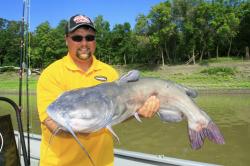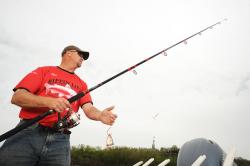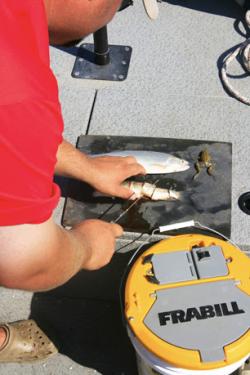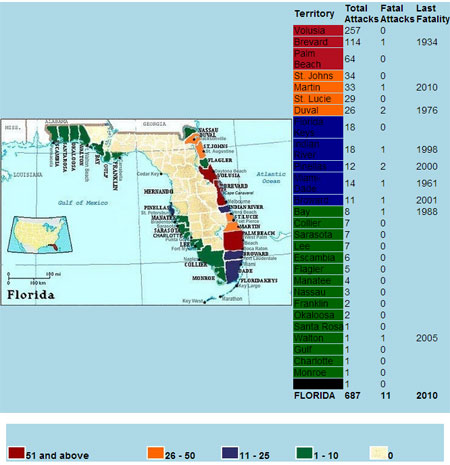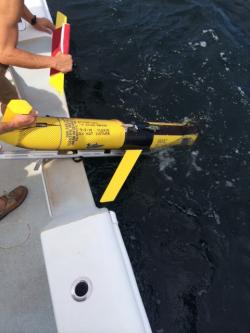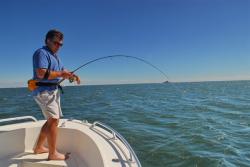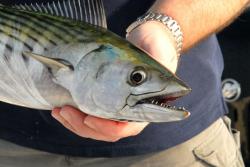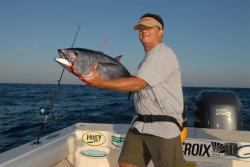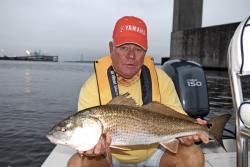Pros Throw Go-To Baits All Summer
from The Fishing Wire
If you could only fish a handful of baits this summer, what would they be? We asked Bassmaster pro Ott Defoe and walleye guide Tom Neustrom, neither of whom hesitated before rattling off a short list of go-to lures.
Rapala and VMC offer an assortment of lures ideal for probing the depths during the heat of summerA Freshwater Hall of Fame Legendary Guide, Neustrom primarily targets walleyes in Minnesota. His top summer baits are the Rapala Scatter Rap, Rapala Husky Jerk, VMC Moon Eye Jig and Rapala Glass Shad Rap.
The 2011 Bassmaster Rookie of the Year, DeFoe hails from rural Knoxville, Tennessee. As a Bassmaster Elite Series and Bassmaster Open tournament competitor, he targets bass all across the country. His top summer baits are a Rapala DT-10, Rapala DT-16, Terminator Pro Series Jig and a VMC Shaky Head Jig.
“With those four baits, man, you should be able to catch a fish anywhere you go,” DeFoe says.
Scatter Rap
Several baits in the Scatter Rap family are in Neustrom’s regular rotation. Built on classic Rapala balsa body shapes, Scatter Raps derive their name and signature sweeping action from an innovative, patent-pending, curved Scatter Lip™.
“I love the Scatter Rap,” Neustrom says. “It’s a great bait with great action, especially when you change the cadence on your retrieve, which changes the action of the bait.”
The Scatter Rap Shad has a unique, erratic action, and dives 5 to 8 feet.Featuring what’s best described as evasive action, baits in the Scatter Rap family perfectly mimic a spooked baitfish fleeing attack, moving from one side to the next, triggering reactive bites.
When Neustrom wants to get Scatter action deeper than a Scatter Rap Shad’s 5- to 8-foot diving depth, he’ll cast a Scatter Rap Countdown, which will sink to whatever depth he wants to fish it. To get it to depth, he simply counts it down, “just like the names says.”
“I like to count ‘one-thousand-one, one-thousand-two,’ and when it do that, I usually get about two- to two-and-a-half feet per ‘one-thousand,'” Neustrom explains. “If you get to ‘five-one-thousand,’ you’re usually down ten feet.”
Once he gets the Scatter Rap Countdown to the strike zone, he slow rolls it back to the boat. “Just lift your rod and reel, pull it back, lift it again, pull it back,” Neustrom explains. “That gives you that erratic action in deeper water.”
Husky Jerk
Neustrom is “really partial to Husky Jerks,” he says. “I’ve caught a lot of smallmouths and walleyes on that bait.”
A natural-looking minnow profile and neutral buoyancy make the Husky Jerk practically irresistible to gamefish. Intermittently pausing the bait on the retrieve is key.
“You just stop reeling that bait and just let it sit there for a couple seconds and then start to reel again,” Neustrom explains. “It’s a great triggering action.”
VMC Moon Eye Jig
When he’s vertical jigging or pitching for walleyes with live minnows, Neustrom will often thread them on a VMC Moon Eye Jig, which features a very effective bait-keeper. “That bait keeper will keep even live bait on the hook, even better than just a straight hook.”
Glass Shad Rap
When trolling for walleyes, Neustrom favors Shad Raps, Scatter Rap Shads and Glass Shad Raps. He ties on the latter in clear water and when he’s needs a little extra running depth.
“I seem to get a little bit better depth with the Glass Rap than a regular Shad Rap,” he says.
His go-to size is a No. 5, which will run 12 1/2 to 14 feet at 2 to 2.5 mph, with 105 feet of Sufix 832 Advanced Superline braid out. His favorite colors are Glass Blue Shad and Glass Perch.
“They just work really, really good in these northern-tier lakes,” he says. “They outproduce a lot of other baits.”
DT-10 and DT-16
Throughout the summer, you’ll find both Rapala DT-10’s and DT-16’s tied on rods on DeFoe’s boat deck.
“Any time the fish are out offshore on deeper structure, as they often are in the summer months, one of those two baits is going to reach the range those fish are in,” he says.
Terminator Pro Series Jig
Not all summer bass live deep. “There’s always fish that live shallow in the summer time,” DeFoe says. “Even when it’s very, very hot.”
Elite Pro Ott DeFoe relies on a variety of lures to score despite hot weather.Flipping a Terminator Pro Series Jig in shallow water is among DeFoe’s favorite ways to catch summer bass. “Those fish, when they want to bite something, a lot of times, they want a big meal,” he explains. “You can put a big trailer on the back of that jig to give you a large profile.”
Featuring a unique head design, the Terminator Pro Series Jig is much more versatile than most jigs – it’s not just for shallow presentations. “You can cast that jig deep too,” Defoe explains. “You can basically do anything you want to do with it.”
Custom jig-skirt colors, color-matched brush guards, a single rattle and a heavy VMC® Black Nickel hook further differentiate the Terminator Pro Series Jig from other cookie-cutter jigs that all pretty much look the same.
VMC Shaky Head
When the going gets tough, DeFoe’s going to break out the spinning tackle and toss a green-pumpkin finesse worm on a VMC Shaky Head Jig.
“When times are tough and you need to get a bite, you can tie on that combination and catch one,” he advises.



